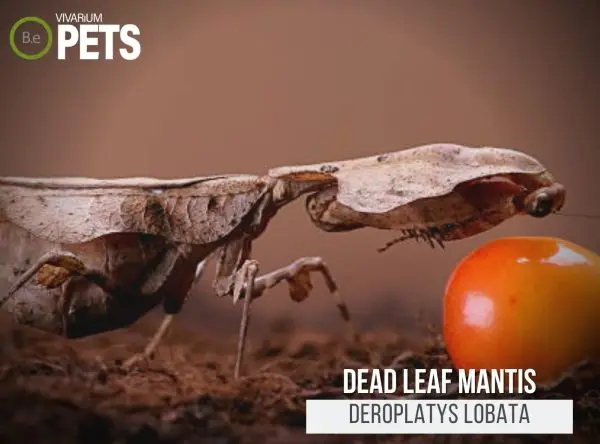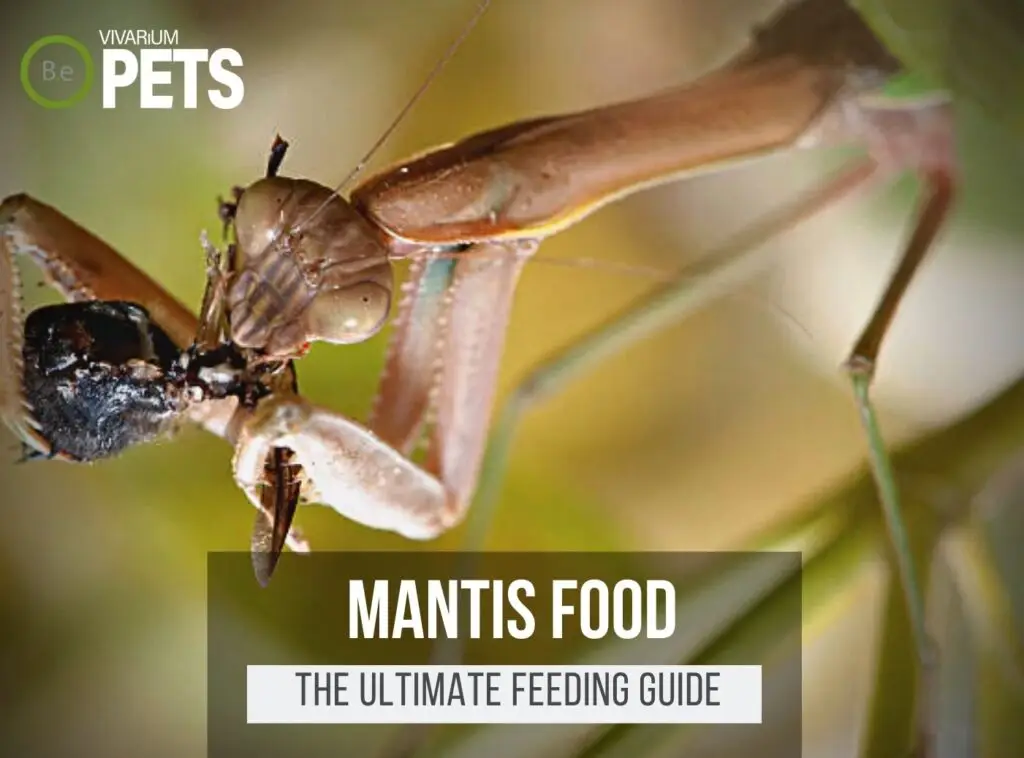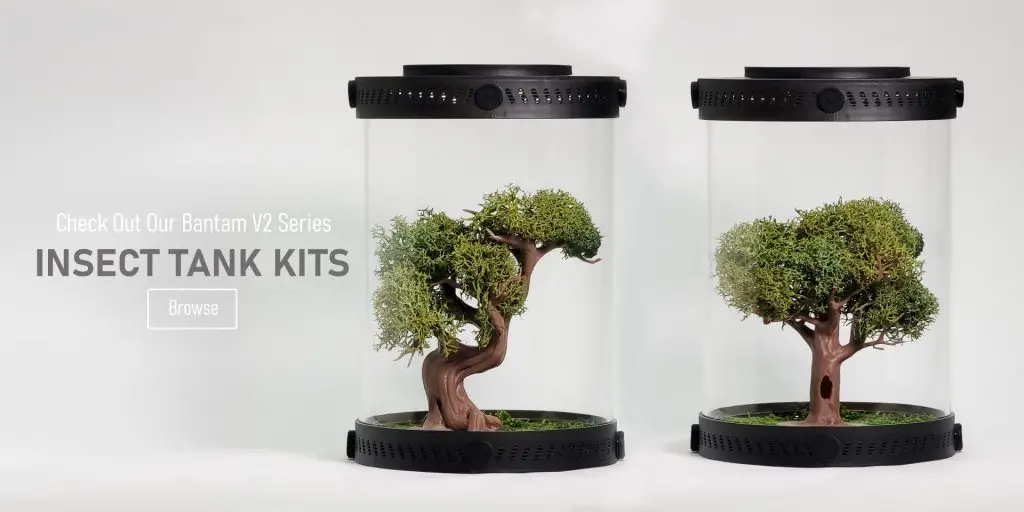Are you in the market for an unusual pet that is both stunningly beautiful and incredibly fascinating to observe throughout its life cycle?
Consider the dead leaf mantis, scientifically known as Deroplatys lobata!
This species of pet praying mantis acts as a camouflage, resembling fallen leaf litter to blend in with its environment.
Read on to find out more about how to provide the best care for your dead leaf mantis!
| Characteristics: | |
|---|---|
| Common Name | Dead Leaf Mantis |
| Family Name | Deroplatyidae |
| Scientific Name | Deroplatys lobata |
| Use | Pets |
| Temperament | Non-aggressive |
| Lifespan | 8 to 16 Months |
| Diet | Insectivore |
| Adult Size | 2 to 4 in |
| Breeding Type | Egg Layer |
| Care Level | Moderate |
| Minimum Tank Size | 5 Gallons |
| pH | 6.5-7.5 |
| Hardness | Moderate |
| Temperature | 70-80°F |
Table Of Contents:
ToggleWhat Are Dead Leaf Mantises?
Deroplatys lobata is an unusual species of praying mantis found in tropical climates.
It belongs to the family Deroplatyidae, commonly known as dead leaf mantises.
This unique creature gets its name from its incredible camouflage in its natural habitat – it resembles dead leaves and is nearly invisible among them!
It is an incredible sight to see these fascinating animals blend in so well with their surroundings – truly a remarkable species!
What Do Dead Leaf Mantises Look Like?
Dead leaf mantises are remarkable among mantis species due to their unique appearance.
Their body resembles that of a dead, dried leaf with intricate veins and details.
Depending on the age and species, they can range from light green to tan in color.
Males typically grow between 2–3 inches in length, with females growing between 3–4 inches.
Females are typically bigger while males are more slender.
Like other mantises, the dead leaf species have powerful raptorial front legs to grab and hold onto prey.
The head section also contains two large compound eyes and two antennae.
The dead leaf mantis also has a fascinating protective shield covering their head with a “spike-like” protrusion near their neck-like area.
The abdomen has four large legs and the wings are similar to the color of their body.
This species has a very flat body form making them great for camouflaging on flat surfaces.
Overall, this insect has an intricate and remarkable look.
Benefits Of Using Dead Leaf Mantises
Deroplatys lobata makes a great critter to keep in a vivarium for a few reasons. For one, they are incredibly fascinating to watch.
With their camouflage coloring, they blend in with their environment, and watching them move and hunt for their prey makes for an interesting wildlife show in your home.
Another advantage of keeping a dead leaf mantis is that its diet typically consists of small bugs which many enclosures have an abundance of.
Furthermore, dead leaf mantises are non-aggressive and mainly solitary, making them nice to keep for beginners just getting into the hobby.

Dead Leaf Mantis Facts
Deroplatys lobata is one of the most fascinating praying mantis species due to its unique choice of camouflage.
They feed on small insects and have a gentle temperament making them perfect pet companions.
On average, they can live up to one year with proper care, and, with a suitable setup, they can breed at 6 months of age.
Habitat
Deroplatys lobata are found in Southeast Asia and are native to Malaysia, Thailand, Singapore, and Indonesia.
They are most commonly found in lowland rainforests and moist, dense forests, where they make their home among ancient trees and foliage.
Dead leaf mantises live in the vegetation of these natural habitats, making them incredibly well-adapted to their environment to protect themselves from predators.
Not only do they look like dead leaves, but they display an interesting survival adaptation tactic of ‘playing dead’ when disturbed.
Create the perfect home for your mantis with our Customizable Mantis Enclosure Kits, designed to meet all their habitat needs.
Diet
Dead leaf mantises, when encountered in their natural habitat, feed mainly on other insects like flies, caterpillars, crickets, and grasshoppers.
In rare cases, they could also cannibalize other mantis species or even consume small vertebrates such as lizards, frogs, and small birds.
As they tend to be ambush predators, they feed mainly during the night when their prey is most vulnerable.
Temperament
Deroplatys lobata is a curious and gentle species, not exhibiting any aggressive behavior towards humans or other animals.
They are quite calm and patient and can be handled without issue.
While they can become skittish with quick movements, they are not prone to attack.
When threatened, they will usually freeze or remain still while assuming their camouflage.
Dead Leaf Mantises are an active and agile species that loves to climb and explore.
They make fantastic observation creatures, never tiring of watching their surroundings.
Despite their small size, they have large appetites and will eagerly look for prey to hunt.
While dead leaf mantids will not usually attack humans, they do need to be handled carefully to ensure that their delicate legs and antennae are not injured.
Lifespan
Dead Leaf Mantises have a lifespan of anywhere between 8 to 16 months, depending on the gender and environment.
The life cycle of mantes like this consists of four main stages: the egg stage, the nymph stage, adulthood, and eventually death.
The egg stage begins when fertilized eggs, known as egg sacs or ootheca, are laid by the female in batches of anywhere from 30 to over 100 eggs.
Once the eggs hatch, the mantis will enter the nymph stage, which will last about 3-4 months and involve multiple molts.
About every two weeks, the mantis will molt and replace its exoskeleton with a larger one.
During this stage, the mantis will need frequent, but small, meals.
The nymphs will eventually reach adulthood, which in most species is marked by the development of wings.
At this stage, the adult will be able to mate and reproduce.
Adults will typically feed on larger prey as well.
Eventually, the mantis will die, usually due to old age or disease.
The owner needs to ensure that the conditions of the environment are kept ideal to maximize the mantis’ lifespan.
Breeding
Deroplatys lobata mate and reproduce similarly to other mantis species, yet there are a few differences due to their unique adaptations.
When ready to mate, the female releases pheromones to attract a male partner.
When the female is ready to accept the male, she slowly moves her wings in a rhythmic beating pattern to accept his courtship.
The female then deposits a single egg capsule, otherwise known as an ootheca.
This capsule contains many eggs for the species to reproduce.
The adults are known to exhibit a form of cannibalism, which is a common occurrence for the majority of the Mantis family.
To prevent the female from killing the male before he can fertilize the eggs, the male must reach the female and approach from the rear of the female’s body.
The female may bite off his wings as a form of mating, or the male may attempt to quickly fertilize the eggs and flee the scene.
Once the eggs have been fertilized and the ootheca deposited, the female will have no further involvement, and the eggs will then be on their own.
Depending on the conditions and temperature in their environment, the eggs can hatch between one and two months.
After hatching, the mantids will go through several stages of molting to reach the adult form.
As the young mantises reach adulthood, they will need to be housed separately to avoid unnecessary threats.
Where To Find Dead Leaf Mantises
Dead leaf mantises can be difficult to find in the wild because they blend in so well with their environment.
However, if you keep an eye out in tropical climates during the rainy season, you may be able to spot one.
If you are looking to buy a mantis, there are online stores that specialize in insects and exotic pets.
Seek to find a seller who ships their mantises quickly and provides helpful customer service.
When purchasing Deroplatys lobata, make sure to inspect it for any signs of illness or injury.
These mantises will often require a few days to acclimate to their new home, so it is best to be prepared in advance with a suitable enclosure and insect food.
Dead Leaf Mantis Care
Caring for Deroplatys lobata is fairly straightforward, but does require creating the right environment for them.
The cage should be a suitable size, with a substrate that offers adequate ventilation and moisture; heating and humidity should be managed to keep the cage within the optimal range.
Dead leaf mantises should be fed common insect prey supplemented with occasional calcium or other nutrient supplements.
Breeders should separate males and females and set up an appropriate space for mating.
As with most animals, keep an eye out for any potential health issues and act accordingly to noticeable symptoms.
Tank Requirements
The ideal enclosure for a Dead leaf mantis is an insectarium or terrarium.
The tank should be tall, rather than wide, as these mantises are climbers.
The enclosure should be well-ventilated and maintain a temperature between 70-80°F and a humidity level of about 70-80%.
A pH of 6.5-7.5 is suitable for optimal health, as well as water hardness of 5-10dH.
The ideal terrarium substrate includes coconut fiber, peat moss, and live vivarium moss.
For terrarium lighting, you can use UVB bulbs but this species does not require UV exposure.
What Do Dead Leaf Mantises Eat?
Feeding Deroplatys lobata is crucial to its health and well-being, and there are many items you can provide.
To start, dead leaf mantises are omnivores, which means they can eat both plants and small insects.
For vegetation, they can eat crushed mushrooms, shredded cabbage, and/or fresh greens.
Insects can make up a large portion of the mantis’s meal plans.
Common insect prey items for these mantises include crickets, locusts, and cockroaches; as well as other small invertebrates like waxworms, fruit flies, small grasshoppers, and aphids.
Make sure that any prey item provided to your mantis is not too much larger than its body size.
Additionally, providing water droplets can keep D. lobata hydrated and help them digest their food.
A small dehumidifier (one designed for reptiles) can also help add hydration to the air.
Finally, we recommend gut-loading any feeder insects with calcium and other nutrients and dusting them occasionally with a vitamin and mineral supplement.
This will ensure your dead leaf mantis receives a proper balance of nutrients.
If you’re looking for a more detailed approach to feeding these critters, be sure to check out my ultimate DIY Praying Mantis food guide. I give a more in-depth explanation of the best foods and my favorite recipe.
Best Tankmates For Dead Leaf Mantises
When considering tankmates for a dead leaf mantis, it’s essential to select species that won’t compete for food or habitat.
Beneficial insects such as roaches stick insects, or even certain spiders make great tankmates because they help with the clean-up of any uneaten prey items.
For the best chance of success, avoid keeping any other insect species that could be mistaken for food or may compete for a potential mate.
Conclusion
Overall, the dead leaf mantis needs special care to remain healthy and thriving, but providing the right environment and diet is worth the effort.
With a well-thought-out setup, Deroplatys lobata will be a source of wonder, entertainment, and even educational value as its life cycle progresses.
We hope that our guide has given you the insight and knowledge necessary to successfully care for this unique species. Good luck!
Create the ideal habitat for your praying mantis with our species-specific soil mixes and Insect Enclosure Kits. These products provide everything you need for a thriving Mantid habitat.
Frequently Asked Questions
No, Dead Leaf Mantises are not typically aggressive. They are known for their camouflage behavior rather than aggressive behavior towards humans or other animals.
Yes, Dead Leaf Mantis can live together, although males and females should be separated as soon as possible to reduce the chances of aggression between the two sexes. Dead Leaf Mantis are known to be peaceful, communal species, and can often be seen sharing branches.
Dead Leaf Mantis (Deroplatys lobataget) can reach an adult size of 1.7–3.5 inches-. They have a long, slender body and are brownish–orange or yellowish in color. They also have long, sharply pointed wings and three pairs of legs that end in small spikes.
Yes, Dead Leaf Mantis are excellent at playing dead, as their camouflage capabilities are remarkable. When they sense danger, they will hang motionless and unfold their wings and legs in order to look like they are part of a dead leaf.
Dead Leaf Mantis camouflage in order to protect themselves from predators and to ambush their prey. Their unique coloring and leaf–like shape enable them to blend in perfectly with their environment.
Dead Leaf Mantis use camouflage to avoid predators by blending in with their environment. Their unique coloring and leaf–like shape enable them to remain unseen. Additionally, they may try to stay still or move away quickly if they sense danger.



